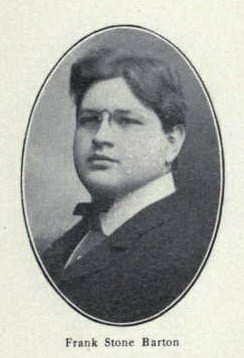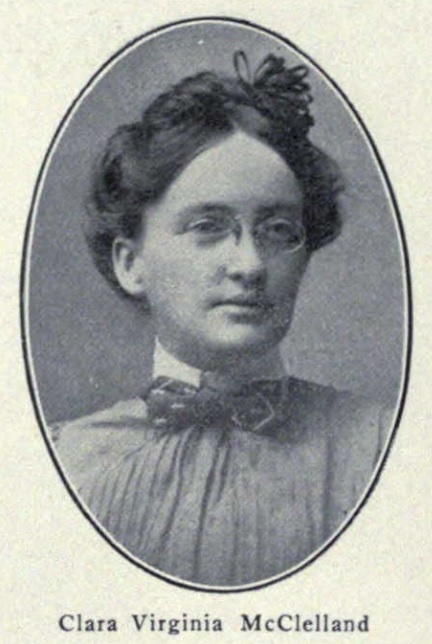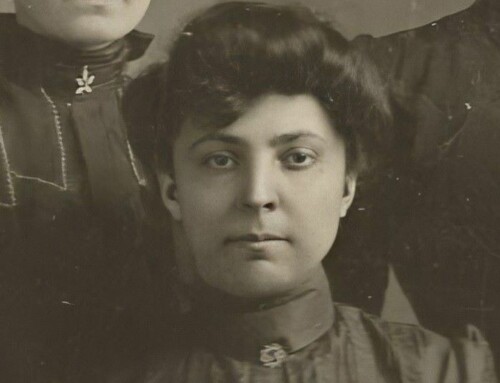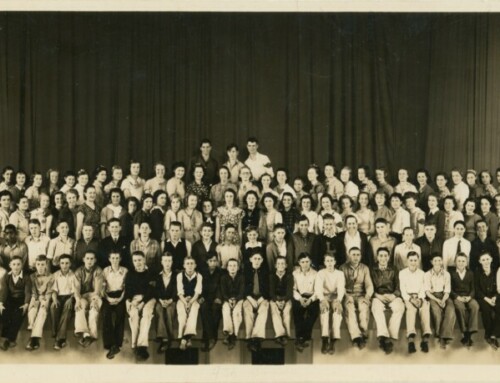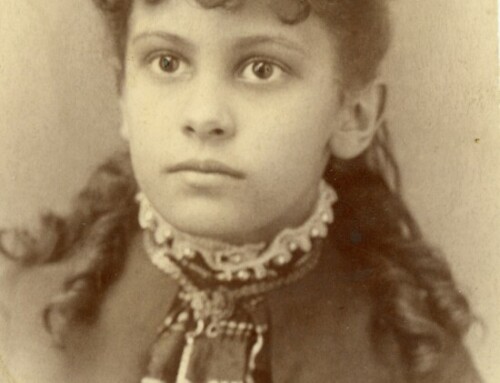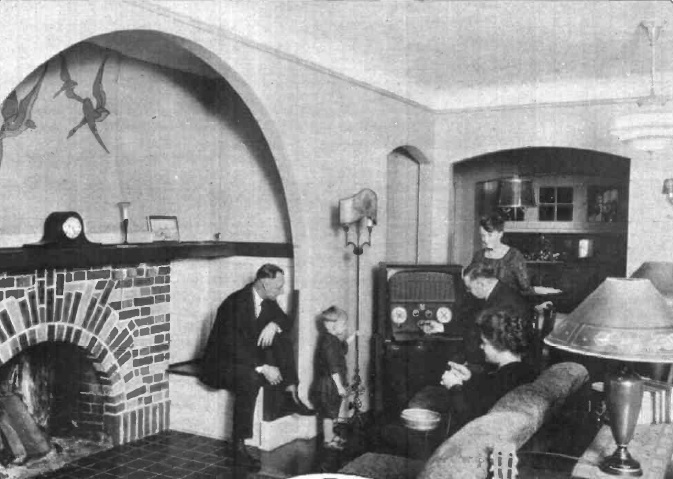
The Barton family gathered around the radio in their home on 901 Capitol St. NE. Their electrical dream home is now the law offices of Gerald L. Warren and Associates.
“We’ve thought and dreamed electrical home service. It is an obsession, perhaps, but…there is hardly a line of home or business life that electricity does not touch, to beautify, to enrich, to adorn.” Frank S. Barton in the December 1, 1921 issue of Statesman Journal
Oftentimes as a monthly column is researched and written, we become more interested in the side stories that come to light. Such was the case with last
month’s article on Salem’s electrified Christmas tree. The more I read about Frank Barton, the visionary man behind the idea, and his Salem Electric store, the more curious I became.
Born January 17, 1881 in Nunda, Livingston county, New York, Frank was the oldest of three children born to Francisco and Mary Barton.[1] The little family moved around a bit during those early years as Francisco, a millwright followed the textile trade in cotton and woolen mills.[2] Daughter Inez was born in Whitewater, Wisconsin on April 27, 1887 and son Richard in Manchester Mill, Virginia on March 29, 1892. In 1900 their mother Mary Barton, after the death of her father, moved her little family back to Nunda to set-up housekeeping with her widowed mother while Francisco remained in Chicago, Illinois. Francisco died in 1917 but left the family well-provided for.[3]
Frank and his future wife Clara Virginia McClelland met while attending Syracuse University in 1903.[4] Frank graduated a few years later with a degree in
electrical engineering. After graduation Frank went to work for General Electric in various capacities. Testing 20,000 kilowatt turbine generators for the New York car lines, then a short stint in Stearns, Kentucky running three large plants for the Coal & Iron Company. The year before their move to Oregon, Frank was the engineer in charge of the New York and Queens Light and Power Company with a large force of electrical and other engineers under him. One of their biggest projects was the continued building, improvement and electrification of elevated railway service.[5]
When the couple arrived in Salem, they opened Salem Electric not to be confused with the current company based in West Salem. The Barton’s Salem Electric store did not manufacture, develop, or transmit electricity. It helped homeowners transition from gas to electric fixtures and appliances, upgrading their homes with modern conveniences.[6] Frank Barton was an unusual combination of decorator, designer, and scientist who believed that electrical fixtures should harmonize with his customer’s home. His beautifully designed globes, glass shades and other fixtures were sold across the country.[7] The shop was located on the ground floor of the Masonic Building[8] directly across from the old Marion County Courthouse and its Norway spruce tree that inspired Frank with the idea of an electrified community Christmas tree, first in the nation.
The culmination of Frank and Clara Barton’s electrical aspirations was the home they built in 1920. Their electrical dream home was built at 901 N. Capitol St.[9], now the law offices of Gerald L. Warren and Associates. It was designed and built with the express idea of demonstrating just how comfortable, convenient, and economical a home outfitted with electricity and modern conveniences could be. Every door had a light switch and electrical outlet high enough that no bending over was needed to plug in the vacuum sweeper.
Housed in the basement was an electric bath heater that provided hot water for bathroom, laundry and kitchen use as well as an electric laundry with a mangle and washer. The kitchen appliances included a hermetically sealed oven with insulated walls that retained heat and an economical automatic shut-off. But probably the piece-de-resistance was the electric sideboard in the dining room with glassed-in compartments for a dozen or so small appliances known as table conveniences. A grill, toaster, percolator, teapot, egg-boiler etc. with plug connections for four appliances at a time. Clara Barton emphatically boasted to a local reporter at the time that “with this convenience, one could sit at the table and cook a meal without ever rising from the chair!”[10]
Both Bartons were active in Salem society, participating in literary and music groups as well as service organizations. Clara was a clever writer whose poems and jingles were regular features in both local and national newspapers and magazines. After winning a country-wide contest for a poem written about radios, her family and their home was featured in the February 1925 edition of Radio in the Home magazine.[11]
In December of the same year, the couple filed for bankruptcy.[12] From newspaper reports at the time it seems clear that a combination of factors contributed to the legal action. The couple had over-extended themselves in building their dream home and out-of-state investors began calling in their debts. Salem businessmen to their credit, were willing to stand behind Frank Barton and wait to be paid, but to no avail.
The house was sold, the store closed and all stock sold off to Vilbert and Todd, another electrical partnership.[13] The following year, the couple moved to Portland. In 1928, two years later we pick up the couple’s story again thanks to a rather odd series of events in online historic newspapers. Frank is discovered injured and unconscious on the streets of Portland, the cause of which would later be determined to be an auto-pedestrian accident.[14] The same day Frank is discovered and admitted to the hospital, his brother Richard receives word of the untimely death of his sister-in-law Clara in Lewiston, Idaho.[15] In follow-up articles, we read that Clara had been living in Idaho for the past 6-8 months working as a waitress when she died from influenza. Her body was returned to Salem for burial, with services taking place on December 31, 1928.[16] Richard made the decision not to inform Frank of his wife’s death until he had sufficiently recovered from his injuries.
Frank would remain at St. Vincent’s hospital in Portland for the next six months, undergoing a series of operations. Doctors eventually diagnosed a brain tumor,[17] which in retrospect could have been a contributing factor in the series of events that led to his hospitalization. In June of 1929 he was discharged to Deaconness hospital in Salem, closer to his brother Richard. Then in April of 1930 we find him listed on the census as a patient in the Oregon State Insane Asylum.[18] His death took place on December 4, 1930 and he was buried alongside Clara in Pioneer Cemetery.[19] Tragic endings for a brilliant entrepreneurial couple who not only established a Christmas tradition in the city of Salem but also helped homes and businesses safely make the transition to electricity and modern conveniences with artistic flair.
This article was written by Kaylyn Mabey for the Statesman Journal where it appeared 15 January 2017. It is reproduced here with references.
[1] WWI Draft Registration Card, 1917-1918, Ancestry.com
[2] Barton-Stone Family History, compiled and written by Inez Lucile [Barton] Wible, transcript available http://www.geocities.ws/idezilla/FamilyTree.html
[3] Ibid.
[4] “Frank Stone Barton,” Who’s Who in Engineering, New York: John W. Leonard Corp., 1925.
[5] Ibid.
[6] “F. S. Barton, Proprietor Salem Electric Company,” Oregon Statesman (Salem, OR), 28 Feb 1924, p. 25.
[7] “The Electric Household is the Home of Comfort and Beautiful Dreams,” Oregon Statesman (Salem, OR), 1 Dec 1921, p.9.
[8] Ibid.
[9] Ibid.
[10] Ibid.
[11] “Radio Brings Poetry to Home of Poetess,” Radio in the Home magazine, Feb 1925, p. 34.
[12] “Salem Electric Co. in Bankruptcy,” Capital Journal (Salem, OR), 17 Dec 1925, p. 9
[13] “Vilbert and Todd Open For Business,” Oregon Statesman (Salem, OR), 17 Dec 1925, p. 23.
[14] “Man Injured by Fall,” Morning Oregonian (Portland, OR), 21 Dec 1928, p. 13.
[15] “Barton Injured Same Day Wife Dies in Idaho,” Oregon Statesman (Salem, OR), 22 Dec 1928, p. 1.
[16] “Barton Funeral To Be In Salem Monday Morning,” Oregon Statesman (Salem, OR), 29 Dec 1928, p. 3.
[17] Daily Capital Journal (Salem, OR), 21 Jun 1929, p 13.
[18] 1930 U.S. Federal Census, Ancestry.com
[19] F.S. Barton, State of Oregon Death Certificate #839, issued 4 Dec 1930.



